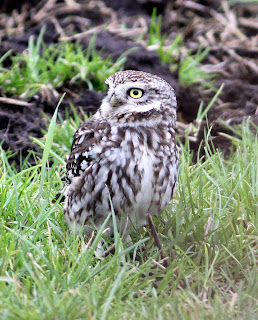The weather outside is pretty foul, grey skies and freezing rain, a promise of snow and not much prospect of sensible birding or ringing for a day or two.
Fortunately Princeton University Press sent Another Bird Blog a copy of the newly published and much awaited Petrels, Albatrosses & Storm-Petrels of North America, A Photographic Guide by Steve N. G. Howell. So I spent the day sat next to a toasting radiator in front of the PC but all at sea with a brilliant book. Read on.
Steve N.G. Howell is a celebrated field ornithologist and writer, an international bird tour leader with WINGS and a research associate at Point Reyes Bird Observatory (PRBO) Conservation Science in California. His books include the Peterson Reference Guide to Moult in North American Birds and Hummingbirds of North America. These are impeccable credentials with which to pen this much needed book about the beautiful but often little known of all the world's birds which live their lives at sea, far from the sight of most people.
When Princeton University Press said they were sending me an early copy the main title didn’t give too much away apart from the fact that the volume might contain information and help towards identifying North American tubenoses. With the additional sub-title of “A Photographic Guide” l perhaps expected a handy, slim, field guide, something in a waterproof cover to take on a lengthy and inevitably wet and probably turbulent, pelagic birding trip.
 Petrels, Albatrosses & Storm-Petrels of North America
Petrels, Albatrosses & Storm-Petrels of North America In real life the book doesn’t resemble my expectation in any way, with the weighty tome having circa 500 hard covered pages with the contents more akin to a comprehensive and scholarly excavation into the mysteries of approximately 70 species of shearwaters, petrels and albatrosses occurring in North America. In the context of the book, North America is defined as waters within 370 km of land from Alaska and Canada, south to the Caribbean and Panama. The “approximately 70 species” hints at the ever changing taxonomic status and challenges to several groups of the tubenoses, taxonomic changes that where applicable are documented, explored and discussed in first-rate detail in the relevant species accounts.
The species accounts comprise headings and text in the form of Identification Summary, Taxonomy, Names, Status and Distribution, Moult, Field Identification, Habitat and Behaviour & Description, generally running into a handful of pages for each. This includes coloured maps which identify the species sea range, migration routes, moulting area and main patterns of occurrence, together with breeding sites for localised species. In the case of some difficult species e.g “Fea’s” Petrel the critical discussion on taxonomy and identification can stretch the highly readable and illuminating content to seven or more pages. Each species has a number of photographs to accompany the text, some of them quite superb, some inevitably less so.
 Petrels, Albatrosses & Storm-Petrels of North America - Fulmar range in North America
Petrels, Albatrosses & Storm-Petrels of North America - Fulmar range in North AmericaAs someone who indulges in a little land-based bird photography I am in admiration of many of the plates in this book, more so when I consider the challenges of taking pictures of a fast flying seabird from a moving boat in weather conditions conjured up by the word “pelagic”. I struggled to pick out just one or two examples to illustrate this feature of the book but settled on the plates below of Fea’s and Zino’s Petrels and then of European Storm Petrel. Note how the discussion of moult and identification is usefully continued into the photographic elements of the pages: the few plates shown here are far from unique in this respect.
 Petrels, Albatrosses & Storm-Petrels of North America - Fea’s Petrel, Zino’s Petrel
Petrels, Albatrosses & Storm-Petrels of North America - Fea’s Petrel, Zino’s Petrel Petrels, Albatrosses & Storm-Petrels of North America – European Storm Petrel
Petrels, Albatrosses & Storm-Petrels of North America – European Storm PetrelA feature I particularly like in each species accounts is the section headed “Names”, a paragraph or two which explains the historic, and oft-changed taxonomic origins of a species name, allowing the reader to reflect upon the enquiring spirit of those in history with an interest in these fascinating seabirds. Looking for an example to quote here I chanced upon the following, which includes reference to a British birder I once had the pleasure of meeting on the Isles of Scilly.
Grant’s (Band-rumped) Storm Petrel – Oceanodroma castro undescribed - means “ocean runner”, “castro” refers to “Roque de Castro” on Madeira, from which Edward Harcourt (1825-1891) described the first known taxon of Band-rumped Storm Petrel. The English name of the cryptic and as yet formally undescribed winter-breeding taxon commemorates British birder Peter Grant (1943-1990) who led the way in challenging identification forums.
To sum up, this is a fine book which covers a good number of the oceans’ wanderers, a volume which all birders and those interested in conservation should aspire to own, and in whichever continent they happen to live. Of the 70 or so species covered by Petrels, Albatrosses & Storm-Petrels of North America approximately one third qualify as vulnerable or endangered by human activity, an overall sad fact given emphasis by the author in devoting two pages to the subject, perhaps not enough, my only minor nit-picking of the whole book.
In the preface the author makes the point that there is still much to learn about Petrels, Albatrosses & Storm-Petrels – “If we know so little about birds as grand and iconic as albatrosses, imagine what else remains to be learned”. I’ll second that Steve, and any minute now I’m about to delve into your book again to do just that.
My advice to any birder out there is to order this book right now. At $45 or £30.95 it is a bargain from
Princeton University Press. Even better at £24.04 from Amazon UK.















































.jpg)












